[EN] Plant Tissues - Supracellular Level // [ES] Tejidos Vegetales - Nivel Supracelular
Respected scholars of the Natural Sciences. In this opportunity I present to you the basics concerning the supracellular level of plant tissues, from the point of view of basic primary education; where it is explained, in a simple and enjoyable way, the primitive stage of how life developed on our planet (cells). From the syncytia and cenocytes to the cenobia. Finally, plant tissues and their differences with animal tissues are briefly explained, as well as their classification according to the function they perform in the plant, or according to the meristematic origin and the cellular elements that compose the "adult" tissues of the plant.
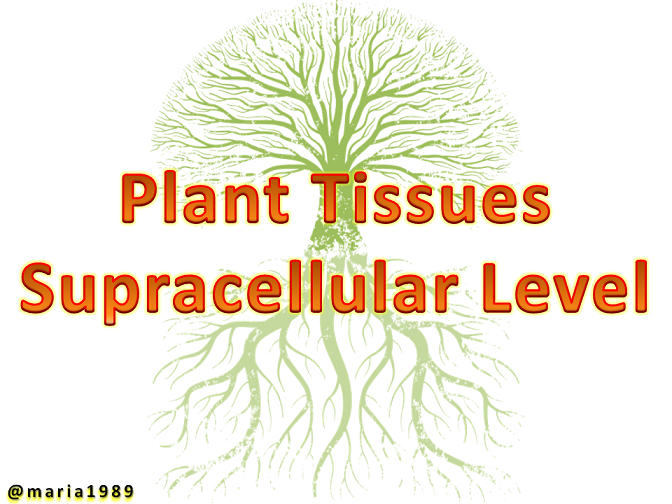
Within the field of Biology there is knowledge of the levels of organization that make mention of the different "degrees of complexity or hierarchy". As life is organized in different ways, from the subatomic particles that form the atoms, which are grouped molecularly (Biochemistry), organizing in a next level where are the "structural units" called Cells, which can reproduce independently and then become Tissues, which develops the complex supracellular level that give rise to the Organs.
“It arises from cellular differentiation and specialization, and encompasses those living beings that are made up of more than one cell. Several degrees of complexity or sublevels can be distinguished. From lesser to greater complexity they are the following: tissues, organs, systems and apparatuses…” Supracellular Level
At a primitive stage in the development of life on our planet, certain unicellular organisms acquired the ability to remain united from the division of a single original cell, which could give rise to cellular aggregates or rudimentary colonies. The study of these aggregates, as they occur in their present forms, suggests two main mechanisms in their formation.
On the one hand there are the so-called syncytia, Plasmodia, which consist of cytoplasmic masses with numerous nuclei in their midst, resulting from the fusion of various cells that have lost their individuality, This structure is present in some plant and animal tissues. They may also have originated by successive divisions of an original nucleus, which have not been accompanied by the corresponding cytoplasmic divisions.
On the other hand, there are the so-called cenobia, colonies of cells derived by simple division of an initial cell. They usually have a spherical shape, as in volvox, and a certain differentiation for reproductive purposes.
A higher level in the formation of supracellular structures is constituted by tissues:
“…They are those biological materials constituted by a complex and organized set of cells, of one or several types, regularly distributed with a coordinated physiological behavior and a common embryonic origin. Histology is the science that studies organic tissues…” Definition of Tissue
There are some similarities between animal and plant tissues because their cells have basic structures such as cytoplasm, plasma membrane, Cytoskeleton and nucleus; both tissues are constituted by cells where each one executes its own function and has its own DNA. But in which there is a clear cellular differentiation and functional specialization. This implies that there are differences between plant tissues with respect to animal tissues. Although both types of tissues are Eukaryotic cells, their differences lie in the constitution of their cells:

D I F F E R E N C E S
- Animal tissue is made up of living cells only, while plant tissue is made up of living and non-living cells
- Animal cells need much more energy to perform their functions, as opposed to plant cells that use less energy for their functions
- The plant cell has pigments such as Chlorophyll, while animal cells lack it
- Cells of animal organisms can move (participate in locomotion) and plant cells cannot (they only provide structural maintenance)
- Animal cells are limited in their growth, as opposed to plant cells which have unlimited growth
- All plant cells have Vacuoles (to engulf substances such as water, enzymes and sugars), which function as limited compartments in their plasma membrane. These vacuoles are only present in certain animal cells
- The metabolism of plant cells is Autotrophic, while the animal cell is Heterotrophic.
- Both types of cells have a plasma membrane, but plant cells have a cell wall that provides rigidity to the plant.
- The animal cell has Centrosome (cell organelle), the plant cell lacks it.
- According to the functions of each type of cell: the plant cell has tissues with structural function; the animal cell forms tissues for locomotion.
Vegetable Tissues
“…These are the tissues found in plants. In a vascular plant, there are differentiated tissues, according to the function they perform: growth tissues (meristems), protective (epidermis and peridermis), fundamental (parenchyma), supporting (collenchyma and sclerenchyma) and conducting (phloem and xylem)…” Vegetable Tissues
Higher plants have developed a series of tissues characterized by their own architecture and cellular typology and by fulfilling a specific function. Thus, there are Meristematic or growth tissues, which allow the plant to increase its length (primary meristems) or thickness (secondary meristems); Protective tissues, such as the Epidermal and Suberosal; Parenchyma, which form the fundamental tissue of the plant, where the functions of photosynthesis, respiration and storage of reserve substances are basically carried out; Mechanical or supporting tissues, such as the Collenchyma, located below the epidermis or parenchyma, and the Sclerenchyma, harder than the previous one and made up of elongated fibers; Conductive tissues, such as the Xylem, composed of woody vessels, whose cells are dead and whose walls are lignified, and the Phloem or liber, formed by the liber vessels, with living cells and excretory tissues, such as the Resiniferous, Latiferous or gomiferous Canal, which with their secretions prevent the entry of external agents and protect the plant.
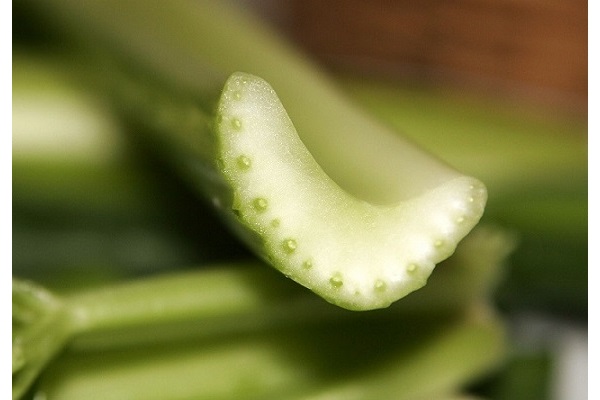
Cut section of a celery stalk, showing the vascular tissue, which includes phloem and xylem

Botany is the natural science of Biology that complements the study of these plant tissues. It provides conclusions in which it affirms that not all plant tissues present the same degree of complexity in the organization of their cells. Those that occupy an inferior organization in the evolutionary scale are the unicellular plants. The grouping of functionally differentiated cells gives rise to a higher level of organization, that of the Thallophytes, constituted by the Thallus, a tissue lacking supporting elements, so that the plants that present it are mainly aquatic and permeable to water. When plants adapt to terrestrial life, the organization called Corm (Cormophyte level) appears, in which there is an external differentiation into roots, stems and leaves, as well as an internal structure in morphologically and physiologically distinct tissues.
T A L O

The numerous small round spheres are floats filled with carbon dioxide.
These provide buoyancy to the algae.
“…It is used to refer to the vegetative tissue of some organisms of diverse groups such as algae, fungi, some liverworts, lichens, and mucilaginous molds. Previously, these groups of organisms were referred to as thallophytes. However, as they are a polyphyletic group of loosely related organisms, this term is no longer used... It is also the multicellular structure characteristic of algae, fungi and some plants and consisting of three basic elements: haptera, stipe and lamellae. In the case of fungi, it is usually called mycelium…” Talo
In algae, fungi and lichens, the typical multicellular thallus appears, originated by the union of independent cells (aggregation consortium) or by the non-separation of cells after each mitosis (filamentous thallus), but in which the cells are always physiologically equivalent and closely united. Although the thallus is usually unidimensional, sometimes, due to the occurrence of regular changes in the plane of the mitotic spindle, branching may occur, thus verifying growth in more than one direction. In the most evolved thalli, those of the phaeophyceae or brown algae, there are outlines of true tissues and external organs similar in appearance to the roots, stems and leaves of the cormophytes. To differentiate them, these "thallose organs" are called: Rizoids for the fixation organs, Cauloids for the support organs, and Phylloids for the photosynthetically active organs. In addition, in Thallophytes, Gametangium and Sporangium are almost always unicellular.
When colonizing the terrestrial environment, plants had to develop support structures, as well as elements for protection against dehydration and systems for conducting water, salts and substances elaborated by the plant itself, which implied a physiological differentiation of cells and their grouping into tissues. These can be classified according to the function they perform in the plant (growth, protection, support, assimilation, conductive, etc.) or according to their origin (meristematic and adult).
M E R I S T E M S
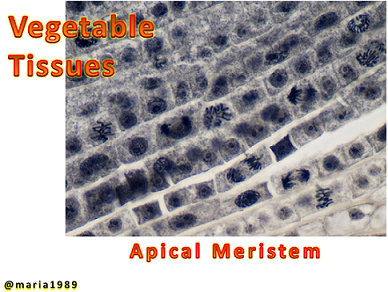
“…They are responsible for plant growth. Its cells are small, polyhedral in shape, with thin walls and small and abundant vacuoles. They are characterized by always remaining young and little differentiated. They have the capacity to divide and from these cells appear the other tissues. This differentiates plants from animals, which reached multicellularity in a completely different way…” Meristems
In the early stages of embryonic development of a plant, growth appears already oriented and an Apical Pole (cauline apex) and a Basal Pole (radical apex), the only points of longitudinal growth of the plant, are visible. The primary meristems, derived directly from the ambrionary cells, are generally made up of small cells, with a very active nucleus, thin membranes and no intercellular space to separate them.
Cells from adult tissues that have redeveloped the ability to reproduce form secondary meristems. When cells from primary meristems are included within an adult tissue, they are called Remnant meristems.
At the end of the stem or root, the latter protected by the Calyptra, is the initial cell, responsible for the longitudinal growth of the plant, while the growth in thickness of stems and roots is due to the secondary meristems called Cambiales (Cambium).
Meristematic tissues are composed of cells that have retained their ability to divide, whereas in adults, the cellular elements have differentiated to perform a specific function, thus losing their reproductive power.
¡ Pleased with your kind attention !
❀@maria1989❀

I dedicate this report to the educational and cultural training
of everyone who knows its importance
and respects the value of integral education.
of everyone who knows its importance
and respects the value of integral education.
Reference articles:
- Histología y organografía vegetal
- Tejidos Vegetales
- Diferencias entre células animal y vegetal
- Tejidos Vegetales (conductores)
- Tejido Vegetal
- Taller de los tejidos vegetales
- Primary, secondary and tertiary meristems
- Niveles de Organización

Respetables estudiosos de las Ciencias Naturales. En esta oportunidad les presento lo básicamente referente al nivel supracelular de los tejidos vegetales, desde el punto de vista de la enseñanza básica primaria; en donde se explica, de manera sencilla y amena, el estadio primitivo de cómo se desarrolló la vida en nuestro planeta (células). Desde los Sincitios y Cenocitos hasta llegar a los Cenobios. Por último, se exponen brevemente, los tejidos vegetales y sus diferencias con el tejido de origen animal; además, se explica su clasificación según la función que desempeña en la planta, o de acuerdo con el origen meristemático y los elementos celulares que componen los tejidos “adultos” de la misma.

Dentro del campo de la Biología se da el conocimiento de los niveles de organización que hacen mención de los diferentes “grados de complejidad o de jerarquía”. Como la vida se organiza en diferentes formas, desde las partículas subatómicas que forman los átomos, los cuales se agrupan molecularmente (Bioquímica), organizándose en un siguiente nivel donde se encuentran las “unidades estructurales” denominadas Células, las cuales pueden reproducirse independientemente y luego se constituyen en Tejidos, lo cual desarrolla el complejo nivel supracelular que dan lugar a los Órganos.
“Surge de la diferenciación y especialización celular, abarca a aquellos seres vivos que están constituidos por más de una célula. Se pueden distinguir varios grados de complejidad o subniveles. De menor a mayor complejidad son los siguientes: tejidos, órganos, sistemas y aparatos…” Nivel Supracelular
En un estadio primitivo del desarrollo de la vida sobre nuestro planeta, ciertos organismos unicelulares adquirieron la capacidad de mantenerse unidos entre sí a partir de la división de una sola célula original, lo que pudo dar lugar a agregados celulares o rudimentarias colonias. El estudio de estos agregados, tal y como se presentan en las formas actuales, sugiere dos mecanismos principales en la formación de los mismos.
Por un lado están los llamados sincitios, Plasmodios, que consisten en masas citoplásmicas con numerosos núcleos en su seno, resultado de la fusión de diversas células que han perdido su individualidad, Esta estructura la presentan algunos tejidos vegetales y animales. También han podido originarse por divisiones sucesivas de un núcleo original, que no han ido acompañadas de las correspondientes divisiones citoplásmicas.
Por otro lado, aparecen los denominados cenobios, colonias de células derivadas por división simple de una célula inicial. Suelen presentar una forma esférica, como ocurre en Volvox, y una cierta diferenciación a efectos de reproducción.
Un grado superior en la formación de estructuras supracelulares lo constituyen los tejidos:
“…Son aquellos materiales biológicos constituidos por un conjunto complejo y organizado de células, de uno o de varios tipos, distribuidas regularmente con un comportamiento fisiológico coordinado y un origen embrionario común. Se llama histología a la ciencia que estudia los tejidos orgánicos…” Definición de tejido
Entre los tejidos animal y vegetal existen algunas semejanzas debido a que sus células poseen estructuras básicas como el citoplasma, la membrana plasmática, el Citoesqueleto y su núcleo; ambos tejidos están constituidos por células en donde cada una ejecuta su propia función y poseen su propio ADN. Pero en las cuales hay una clara diferenciación celular y una especialización funcional. Esto implica que, existen diferencias entre los tejidos vegetales con respecto a los tejidos animales. Muy a pesar de que ambos tipos de tejidos son células Eucariotas, sus diferencias, radican en la constitución de sus células:
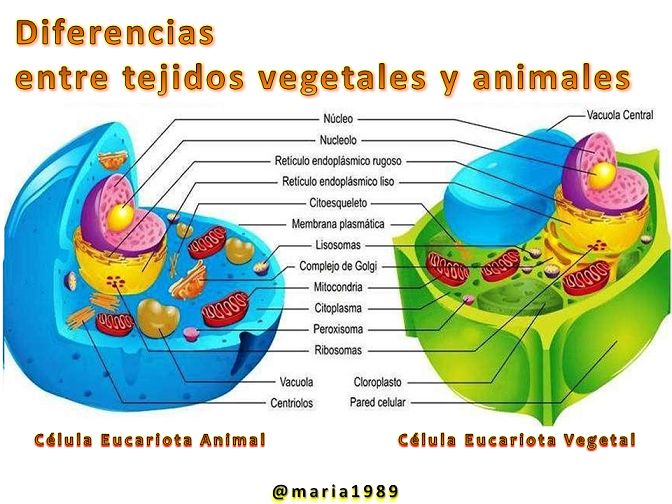
D I F E R E N C I A S
- El tejido animal se conforma por células vivas solamente, mientras que el tejido vegetal se forma por células vivas y no vivas
- Las células animales necesitan mucho más energía para ejecutar sus funciones, en comparación contraria a las células vegetales que gastan menos energía para sus funciones
- La célula vegetal tiene pigmentos como Clorofila, mientras que las células animales carecen de ella
- Las células de los organismos animales pueden moverse (participan en la locomoción) y las células vegetales no (sólo proporcionan mantenimiento estructural)
- Las células de los animales presentan limitación en su crecimiento, lo contrario a las células vegetales que poseen un crecimiento ilimitado
- Todas las células vegetales poseen Vacuolas (para englobar sustancias como agua, enzimas y azúcares), funcionan como compartimientos limitados en su membrana plasmática. Estas vacuolas sólo están presentes en ciertas células animales
- El metabolismo de las células vegetales es Autótrofo, mientras que la célula animal es Heterótrofago
- Ambos tipos de células poseen membrana plasmática, pero las vegetales presentan una pared celular que proporcionar rigidez a la planta
- La célula animal posee Centrosoma (orgánulo celular), la vegetal lo carece
- De acuerdo a las funciones de cada tipo de célula: la vegetal, tiene tejidos con función estructural; la animal, forma tejidos en función a la locomoción
Tejidos Vegetales
“…Son aquellos que se encuentran en las plantas. En una planta vascular, existen tejidos diferenciados, de acuerdo con la función que desempeñan: tejidos de crecimiento (meristemas), protectores (epidermis y peridermis), fundamentales (parénquima), de sostén (colénquima y esclerénquima) y conductores (floema y xilema)…” Tejidos Vegetales
Los vegetales superiores han desarrollado una serie de tejidos caracterizados por presentar una arquitectura y tipología celulares propias y por cumplir una función específica. Así, hay Tejidos Meristemáticos o de crecimiento, que permiten al vegetal incrementar su longitud (meristemos primarios) o su grosor (meristemas secundarios); Tejidos de Protección, como el Epidérmico y el Suberoso; Parénquimas, que forman el tejido fundamental de la planta, donde se realizan básicamente las funciones de fotosíntesis, respiración y almacenamiento de sustancias de reserva; Tejidos Mecánicos o de sostén, como el Colénquima, situado debajo de la epidermis o del parénquima, y el Esclerénquima, más duro que el anterior y constituido por fibras alargadas; Tejidos Conductores, como el Xilema, integrado por los vasos leñosos, cuyas células están muertas y sus paredes lignificadas, y el Floema o liber, formados por los vasos liberianos, con células vivas y tejidos excretores, como el Canal Resinífero, Laticíferos o gomíferos, que con sus secreciones impiden la entrada de agentes externos y protegen a la planta.

Sección del corte de un tallo de apio, mostrando el tejido vascular, que incluye floema y xilema

La Botánica, es la ciencia natural de la Biología que complementa el estudio de estos tejidos vegetales. La cual, aporta conclusiones en donde afirma que, no todos los tejidos vegetales presentan el mismo grado de complejidad en la organización de sus células. Los que ocupan una organización inferior en la escala evolutiva son los vegetales unicelulares. La agrupación de las células funcionalmente diferenciadas da lugar a un nivel de organización superior, el de los Talofitos, constituido por el Talo, tejido carente de elementos de sostén, por lo que las plantas que lo presentan son principalmente acuáticas y permeables al agua. Cuando los vegetales se adaptan a la vida terrestre, aparece la organización denominada Cormo (nivel de los Cormofitos), en la que se da una diferenciación externa en raíces, tallos y hojas, así como una estructura interna en tejidos morfológica y fisiológicamente distintos.
T A L O
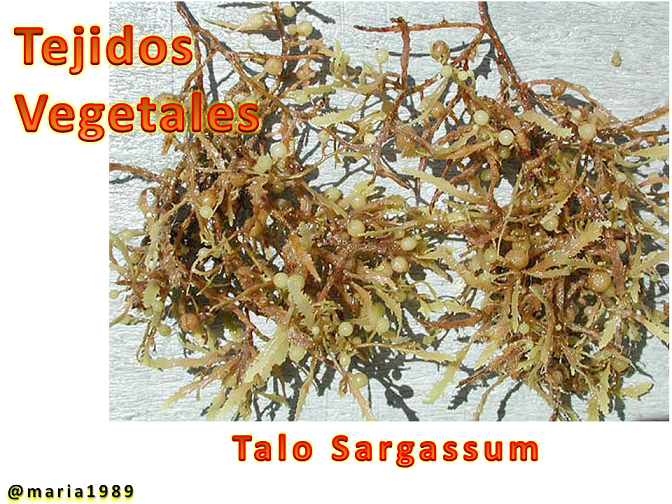
Las numerosas esferas redondas son flotadores llenos de dióxido de carbono.
Éstas proporcionan flotabilidad a las algas.
“…Se utiliza para referirse al tejido vegetativo de algunos organismos de grupos diversos como algas, hongos, algunos hepáticas, líquenes, y mohos mucilaginosos. Anteriormente se englobaba a estos grupos de organismos como talofitas. Sin embargo, como se trata de un grupo polifilético de organismos poco relacionados, este término no se utiliza más… También es la estructura pluricelular propia de las algas, hongos y algunas plantas y que consta de tres elementos básicos: haptera, estipe y laminillas. En el caso de los hongos acostumbra a llamarse micelio…” Talo
En las algas, hongos y líquenes aparece el típico talo pluricelular, originado por la unión de células independientes (consorcio de agregación) o por la no separación celular después de cada mitosis (talo filamentoso), pero en el que las células son siempre equivalentes desde el punto de vista fisiológico y están estrechamente unidas entre sí. Aunque el talo suele ser unidimensional, a veces, debido a la aparición de cambios regulares en el plano del huso mitótico, pueden surgir ramificaciones, verificándose entonces el crecimiento en más de una dirección. En los talos más evolucionados, los de las feofíceas o algas pardas, aparecen esbozos de verdaderos tejidos y órganos externos de aspecto semejante a las raíces, tallos y hojas de los cormofitos. Para diferenciarlos, estos “órganos talosos” se llaman: Rizoides para los de fijación, Cauloides los de sostén, y Filoides los fotosintéticamente activos. Además, en los Talofitos, los Gametangios y Esporangios son casi siempre unicelulares.
Al colonizar el medio terrestre, las plantas tuvieron que desarrollar estructuras de sostén, así como elementos de protección frente a la deshidratación y sistemas conductores del agua, las sales y las sustancias elaboradas por el propio vegetal; lo cual implicó, una diferenciación fisiológica de las células y su agrupación en tejidos. Estos pueden clasificarse según la función que desempeñan en el vegetal (funciones de crecimiento, de protección, de sostén, de asimilación, conductores, etc.) o de acuerdo con su origen (meristemáticos y adultos).
M E R I S T E M O S
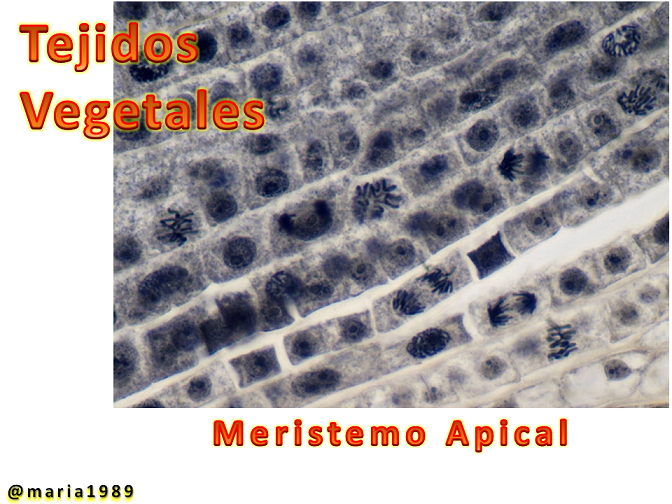
“…Son los responsables del crecimiento vegetal. Sus células son pequeñas, tienen forma poliédrica, paredes finas y vacuolas pequeñas y abundantes. Se caracteriza por mantenerse siempre joven y poco diferenciado. Tienen capacidad de división y de estas células aparecen los demás tejidos. Lo cual diferencia los vegetales de los animales que llegaron a la multicelularidad de una forma completamente diferente…” Meristemos
En los primeros estadios del desarrollo embrionario de una planta, el crecimiento aparece ya orientado y se aprecian un Polo Apical (ápice caulinar) y un Polo Basal (ápice radical), únicos puntos de crecimiento longitudinal del vegetal. Los meristemos primarios, derivados directamente de las células ambrionarias, están constituidos por células generalmente pequeñas, de núcleo muy activo, membranas poco gruesas y sin espacio intercelular que las separe.
Las células de tejidos adultos que han vuelto a desarrollar la capacidad de reproducción forman los meristemos secundarios. Cuando las células procedentes de los meristemos primarios se encuentran incluidas dentro de un tejido adulto se habla de Meristemas Remanentes.
En el extremo del tallo o de la raíz, esta última protegida por la Caliptra, se encuentra la célula inicial, responsable del crecimiento longitudinal de la planta, mientras que el crecimiento en grosor de tallos y raíces se debe a los meristemos secundarios denominados Cambiales (Cambium).
Los tejidos meristemáticos están integrados por células que han conservado su capacidad de división, mientras que en los adultos, los elementos celulares se han diferenciado para realizar una función concreta, con lo que han perdido su poder reproductivo.
¡ Complacida por su amable atención !
❀@maria1989❀

Dedico este informe a la formación educativa y cultural
de todo aquel que conoce su importancia
y respeta lo valioso de la educación integral
de todo aquel que conoce su importancia
y respeta lo valioso de la educación integral
Artículos de consulta:
- Histología y organografía vegetal
- Tejidos Vegetales
- Diferencias entre células animal y vegetal
- Tejidos Vegetales (conductores)
- Tejido Vegetal
- Taller de los tejidos vegetales
- Primary, secondary and tertiary meristems
- Niveles de Organización
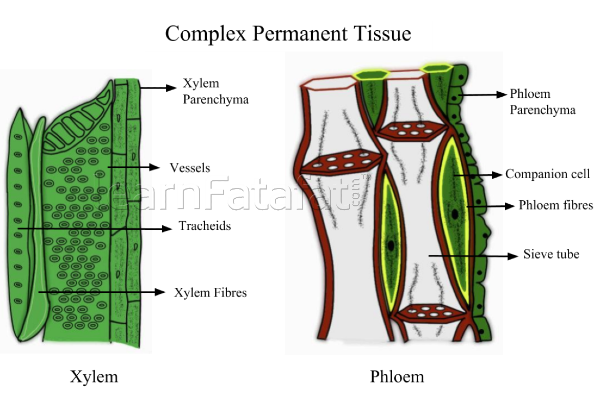
I know how much you work with care to show off your publications. As well as this research that for much quality that has almost no one stops to read it and do justice to it by voting for its content.
Keep on, insist, at some point they will recognize your work.
I love you. God bless you.
Se de lo mucho que obras con esmero para lucir tus publicaciones. Así como esta investigación que por mucha calidad que posee casi nadie se detiene a leerla y hacerle justicia votando por su contenido.
Sígue, insiste, en algún momento reconocerán tu trabajo.
Te amo. Dios te bendiga.